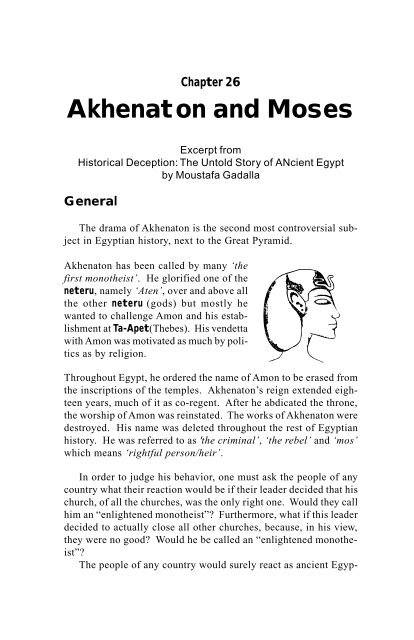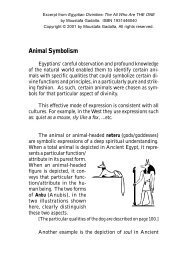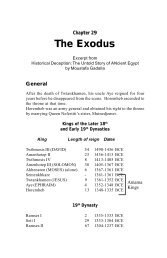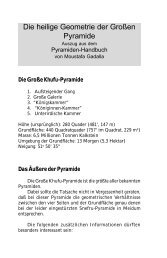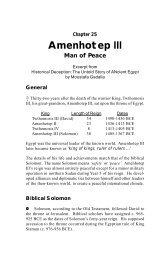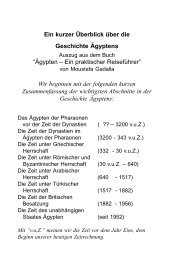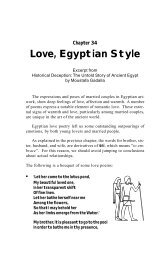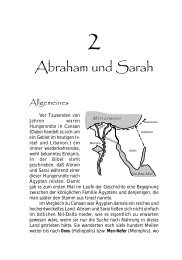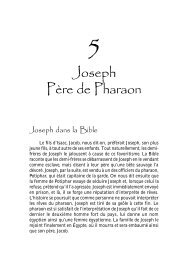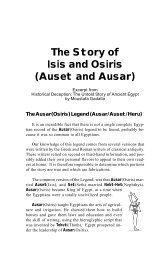Akhenaton and Moses - Tehuti Research Foundation
Akhenaton and Moses - Tehuti Research Foundation
Akhenaton and Moses - Tehuti Research Foundation
You also want an ePaper? Increase the reach of your titles
YUMPU automatically turns print PDFs into web optimized ePapers that Google loves.
Chapter 26<br />
<strong>Akhenaton</strong> <strong>and</strong> <strong>Moses</strong><br />
Excerpt from<br />
Historical Deception: The Untold Story of ANcient Egypt<br />
by Moustafa Gadalla<br />
General<br />
The drama of <strong>Akhenaton</strong> is the second most controversial subject<br />
in Egyptian history, next to the Great Pyramid.<br />
<strong>Akhenaton</strong> has been called by many ‘the<br />
first monotheist’. He glorified one of the<br />
neteru, namely ‘Aten’, over <strong>and</strong> above all<br />
the other neteru (gods) but mostly he<br />
wanted to challenge Amon <strong>and</strong> his establishment<br />
at Ta-Apet(Thebes). His vendetta<br />
with Amon was motivated as much by politics<br />
as by religion.<br />
Throughout Egypt, he ordered the name of Amon to be erased from<br />
the inscriptions of the temples. <strong>Akhenaton</strong>’s reign extended eighteen<br />
years, much of it as co-regent. After he abdicated the throne,<br />
the worship of Amon was reinstated. The works of <strong>Akhenaton</strong> were<br />
destroyed. His name was deleted throughout the rest of Egyptian<br />
history. He was referred to as ‘the criminal’, ‘the rebel’ <strong>and</strong> ‘mos’<br />
which means ‘rightful person/heir’.<br />
In order to judge his behavior, one must ask the people of any<br />
country what their reaction would be if their leader decided that his<br />
church, of all the churches, was the only right one. Would they call<br />
him an “enlightened monotheist”? Furthermore, what if this leader<br />
decided to actually close all other churches, because, in his view,<br />
they were no good? Would he be called an “enlightened monotheist”?<br />
The people of any country would surely react as ancient Egyp-
188 Historical Deception: The Untold Story of Ancient Egypt<br />
tians reacted, because their leader would not be an enlightened<br />
monotheist, but a tyrannical dictator.<br />
Sigmund Freud <strong>Research</strong><br />
Sigmund Freud, the Jewish father of psychoanalysis, was interested<br />
in reading about <strong>Akhenaton</strong> <strong>and</strong> <strong>Moses</strong>. He later wrote a<br />
book called <strong>Moses</strong> <strong>and</strong> Monotheism. Sigmund Freud argued that<br />
<strong>Moses</strong> was an Egyptian, a follower of <strong>Akhenaton</strong>, who later led the<br />
Jews out of Egypt.<br />
Freud also came to the conclusion that ‘<strong>Moses</strong>’ was itself an<br />
Egyptian name.<br />
Even though the Bible in Exodus, 2:10 tells us that <strong>Moses</strong>’<br />
royal mother, who adopted him, called him Moshe because, she<br />
said, “I drew him out of the water”, Freud demonstrated that<br />
Moshe had a different meaning. In fact, the Hebrew word m sh a, as<br />
a verb, can mean either ‘to draw’ or ‘one who draws out’. The name<br />
Moshui, is the one that means ‘one who has been drawn out’. It<br />
was then Freud’s conclusion that the name of the Jewish leader was<br />
not of Hebrew origin, but comes from the Egyptian word, mos,<br />
meaning a rightful person.<br />
Later, Freud came very close to demonstrating that <strong>Akhenaton</strong><br />
<strong>and</strong> <strong>Moses</strong> were one <strong>and</strong> the same person. In 1937, Imago published<br />
another article by Freud under the title ‘If <strong>Moses</strong> was an<br />
Egyptian’. Freud found great similarity between the new religion<br />
that <strong>Akhenaton</strong> had tried to impose on his country <strong>and</strong> the religious<br />
teaching ascribed to <strong>Moses</strong>. Sigmund Freud wrote: “The<br />
Jewish creed says: ‘Schema Yisrael Adonai Elohenu Adonai<br />
Echod’.” (‘Hear, 0 Israel, the Lord thy God is one God’.) The Hebrew<br />
letter ‘d’ is equivalent to the Egyptian letter ‘t’ <strong>and</strong> the Hebrew<br />
‘e’ becomes the Egyptian ‘o’. Therefore this sentence from<br />
the Jewish creed could be translated: “Hear, 0 Israel, our God<br />
Aten is the only God.” <strong>Akhenaton</strong>, as stated earlier, declared that<br />
Aten is the only God.<br />
The similarity between the religions of <strong>Moses</strong> <strong>and</strong> <strong>Akhenaton</strong><br />
as raised in Sigmund Freud’s book, <strong>Moses</strong> <strong>and</strong> Monotheism, has
<strong>Akhenaton</strong> <strong>and</strong> <strong>Moses</strong><br />
caused endless argument about this subject.<br />
Childhood<br />
189<br />
<strong>Akhenaton</strong>’s father, Amenhotep III, met <strong>and</strong> fell in love with<br />
Yuya’s daughter, Tiye. In order to inherit the throne, Amenhotep III<br />
married his half-sister Sitamun. He shortly thereafter married Tiye,<br />
the half-Egyptian. To add insult to injury, he made Tiye rather than<br />
Sitamun, his Great Royal Wife (queen).<br />
Amenhotep III’s marital actions were irresponsible <strong>and</strong> must have<br />
created a poisonous atmosphere.<br />
Later, Tiye had a son, Twthomosis, who was educated <strong>and</strong> trained at<br />
Men-Nefer(Memphis) <strong>and</strong> who held the title of the High Priest of<br />
Ptah, as did most heirs-apparent during the 18 th Dynasty, but then<br />
he disappeared suddenly from the scene.<br />
There may have been imminent danger awaiting Tiye’s sons. She<br />
was of mixed Egyptian-Israelite blood, <strong>and</strong> if her son succeeded to<br />
the throne, this would be regarded as forming a new dynasty of<br />
non-Egyptian, part-Israelite rulers over Egypt.<br />
Her second son was born, probably in 1394 BCE, at the fortified<br />
frontier city of Zarw. He was named Amenhotep IV (later to be<br />
known as <strong>Akhenaton</strong>).<br />
Upon <strong>Akhenaton</strong>’s birth, Tiye sent him by water to the safety of<br />
her Israelite relations at nearby Goshen. This event is echoed in the<br />
biblical story of <strong>Moses</strong> being found by a princess in the bulrushes<br />
by the bank of the Nile.<br />
The imminent danger to Tiye’s sons is echoed in the Talmud, which<br />
provides a different reason for the attempt to kill <strong>Moses</strong> at birth. It<br />
was <strong>Moses</strong> specifically (not all other Hebrew children) who was to<br />
be murdered because he posed a threat to the throne of Egypt.<br />
The Bible gave the impression that <strong>Moses</strong> was the first-born in<br />
his family. We find out later that he already had an elder sister,
190 Historical Deception: The Untold Story of Ancient Egypt<br />
Miriam, who was quietly watching him floating on the water. She<br />
approached the Pharaoh’s daughter <strong>and</strong> offered: “Shall I fetch one<br />
of the Hebrew women to nurse the baby for you?” When the<br />
offer was accepted, the sister got her mother. The mother agreed to<br />
nurse her own baby in return for payment.<br />
Later, when the child grew older, she took him back to the Pharaoh’s<br />
daughter, who adopted him as her son. Then she, we are told, gave<br />
him the name <strong>Moses</strong>.<br />
Some comments about these biblical events:<br />
1- As we can see from the case of the Patriarch Joseph, when the<br />
Pharaoh appointed him as his vizier he gave him an Egyptian<br />
name to go with his new Egyptian identity. Does it make sense<br />
for the royal mother of <strong>Moses</strong> to give her adopted Egyptian son<br />
a Hebrew name?!<br />
2- Can we expect the Egyptian royal mother to have sufficient, or<br />
any, knowledge of the Hebrew language to be able to choose a<br />
special Hebrew name for the child?<br />
3- The biblical claim that the Pharaoh’s<br />
daughter adopted the child is inherently<br />
improbable. The customs of the<br />
time would not have allowed an unmarried<br />
princess to adopt a child.<br />
4- Finally, the biblical story of two mothers<br />
fighting over the parenthood of a<br />
child who went to Solomon to resolve<br />
their dispute (I Kings 3:16-28) is strikingly<br />
similar to the account of <strong>Moses</strong><br />
growing up in the Pharaoh’s palace,<br />
where he had “two mothers”. Solomon,<br />
the King of Kings, would not have gotten involved in a dispute<br />
between two women, unless the dispute was in his household.<br />
In either case of <strong>Akhenaton</strong> or <strong>Moses</strong>, we know very little of<br />
their early years beyond the fact that both had an extremely close
elationship with their mother.<br />
<strong>Akhenaton</strong> <strong>and</strong> <strong>Moses</strong><br />
<strong>Akhenaton</strong> spent most of his youth in the<br />
Eastern Delta <strong>and</strong> at Heliopolis. In the Eastern<br />
Delta area he was influenced by Aten. At<br />
Onnu(Heliopolis), he was educated by the priests<br />
of Ra, the ancient Egyptian solar deity.<br />
Early historians stated that the biblical <strong>Moses</strong><br />
spent his early youth at Onnu(Heliopolis).<br />
191<br />
There is no evidence that <strong>Akhenaton</strong>/<strong>Moses</strong> spent his early days<br />
at Men-Nefer(Memphis), where his father had his main residence at<br />
the time <strong>and</strong> where the heirs apparent were normally trained <strong>and</strong><br />
educated with the sons of the nobles.<br />
When he was in his very early teens, Amenhotep IV was finally<br />
allowed to take up residence at Ta-Apet(Thebes). The Amonite priests<br />
<strong>and</strong> nobles of Egypt, the protectors of old traditions, regarded<br />
<strong>Akhenaton</strong> with contempt for his mixed race. It was not he who<br />
first rejected them, it was they, the Amonists, who refused to accept<br />
him as the legitimate heir to the throne.<br />
When Amenhotep III’s health began to deteriorate, Tiye’s power<br />
increased correspondingly. In order to ensure her son’s inheritance<br />
of the throne, she arranged for him to marry his half-sister, Nefertiti.<br />
She was the daughter of Amenhotep III by his sister, Sitamun, the<br />
legitimate heiress. Thus Nefertiti is recognized in the Bible as<br />
Miriam, <strong>Moses</strong>’ sister.<br />
Tiye prompted her husb<strong>and</strong>, Amenhotep III, to appoint Amenhotep<br />
IV (<strong>Akhenaton</strong>) as his co-regent.<br />
Queen Tiye was definitely the power behind the throne, at the<br />
time. Her name, unlike that of earlier queens, was placed regularly<br />
in a cartouche — a distinction previously limited to the ruling<br />
monarch. Furthermore, she was represented as being of equivalent<br />
stature to the king, Amenhotep III.<br />
The Name “<strong>Moses</strong>”
192 Historical Deception: The Untold Story of Ancient Egypt<br />
As explained earlier, the biblical explanation of the name is<br />
incorrect.<br />
In Ancient Egyptian, this word, meaning a rightful person/heir,<br />
consists of two consonants, ‘m’ <strong>and</strong> ‘s’. If we take away the two<br />
vowels ‘o’ <strong>and</strong> ‘e’ from Moshe (the Jewish name for <strong>Moses</strong>) we are<br />
left with only two consonants, ‘m’ <strong>and</strong> ‘sh’. As the Hebrew letter<br />
‘sh’ is the equivalent of the Egyptian ‘s’, one is able to conclude<br />
that the Hebrew word came from the Egyptian word. In both Hebrew<br />
<strong>and</strong> Egyptian, short vowels, although always pronounced,<br />
were never written.<br />
As for the name <strong>Moses</strong>, the ‘s’ at the end of the name is drawn<br />
from the Greek translation of the biblical name.<br />
Mos was part of many compound Egyptian names such as Ptahmos<br />
<strong>and</strong> Twth-mos. We also find some examples of the word mos<br />
being used on its own as a personal pronoun <strong>and</strong> which means<br />
rightful person. Such practice began during the 18 th Dynasty.<br />
Once <strong>Akhenaton</strong> was no longer on the throne, use of his royal<br />
names was forbidden, <strong>and</strong> he was referred to officially in later times<br />
as ‘The Fallen One of Akhetaten (Amarna)’ <strong>and</strong> ‘The Rebel of Akhetaten’.<br />
The Israelites may have called him mos to indicate that he was the<br />
legitimate son of Amenhotep III <strong>and</strong> the rightful heir to his father’s<br />
throne.<br />
Many generations later <strong>and</strong> in a different country, the biblical<br />
editor, who may not have had any knowledge of <strong>Moses</strong>’ original<br />
name, attempted to provide a Hebrew explanation. It is also possible<br />
that the biblical editor was trying to remove any possible link<br />
between <strong>Moses</strong> <strong>and</strong> his position as the Pharaoh of Egypt.<br />
Brother Aaron<br />
The Bible tells us that <strong>Moses</strong> has a brother called Aaron, a long<br />
time after <strong>Moses</strong>’ birth.<br />
Was Aaron a biological brother or a feeding brother? In the biblical<br />
era <strong>and</strong> even today, Bedouin mothers regularly nurse each others’<br />
babies when they get hungry. The children of both mothers know
each other as brothers <strong>and</strong> sisters.<br />
<strong>Akhenaton</strong> <strong>and</strong> <strong>Moses</strong><br />
193<br />
Thus, the woman who nursed <strong>Moses</strong> would have been called his<br />
mother. Her real son, Aaron, was simply what the Bedouins, call ‘a<br />
feeding brother’ to <strong>Moses</strong>.<br />
Aaron played an important role, when <strong>Moses</strong> went back to Egypt<br />
to challenge the ruling Pharaoh.<br />
Aten Worship<br />
There were very many neteru in Egypt who represented the many<br />
aspects/attributes of the one Supreme. Aten was among this multitude<br />
of deities, <strong>and</strong> it was not<br />
a new idea that was introduced<br />
by <strong>Akhenaton</strong>. Aten<br />
does appear in a few texts<br />
from the time of the 12 th Dynasty.<br />
It appeared frequently<br />
since the time of Twthomosis<br />
IV (1401-1391 BCE).<br />
<strong>Akhenaton</strong> exalted Aten over<br />
<strong>and</strong> above the others. Aten is<br />
the disk of the sun as physical<br />
manifestation of Ra.<br />
Adonai in Hebrew means<br />
‘my Lord’. The last two letters<br />
‘ai’ of the word is a Hebrew<br />
pronoun meaning ‘my’<br />
or ‘mine’ <strong>and</strong> signifying possession. ‘Adon’ meaning Lord was<br />
correctly noted by Sigmund Freud, as the Hebrew word for the Egyptian<br />
‘Aten’. As the Egyptian ‘t’ becomes ‘d’ in Hebrew <strong>and</strong> the<br />
vowel ‘e’ becomes an ‘o’, Adon is the Hebrew equivalent of the<br />
Egyptian Aten.<br />
Thus Adon <strong>and</strong> Aten are one <strong>and</strong> the same.<br />
The hymn to Aten, which is attributed to <strong>Akhenaton</strong>, is a mirror
194 Historical Deception: The Untold Story of Ancient Egypt<br />
image of Psalm 104. Below, are both versions for you to compare:<br />
Hymn to the Aten<br />
The cattle are content in their pasture, the trees <strong>and</strong><br />
plants are green, the birds fly from their nests. Their wings<br />
are raised in praise of your soul. The goats leap on their feet.<br />
All flying <strong>and</strong> fluttering things live when you shine for them.<br />
Likewise the boats race up <strong>and</strong> down the river, <strong>and</strong> every way<br />
is open, because you have appeared. The fish in the river leap<br />
before your face. Your rays go to the depth of the sea.<br />
Psalm 104<br />
He He causeth causeth the the grass grass to to grow grow for for the the cattle, cattle, <strong>and</strong><br />
<strong>and</strong><br />
the the herb herb for for the the service service of of man: man: that that he he may may bring<br />
bring<br />
forth forth forth food food out out out of of the the earth: earth: earth: <strong>and</strong> <strong>and</strong> wine wine that that maketh<br />
maketh<br />
glad glad the the heart heart of of man man <strong>and</strong> <strong>and</strong> oil oil to to make make make his his face<br />
face<br />
shine, shine, <strong>and</strong> <strong>and</strong> <strong>and</strong> bread bread which which strengtheneth strengtheneth man’s<br />
man’s<br />
heart. heart. The The trees trees of of the the Lord Lord are are full full of of sap: sap: the<br />
the<br />
cedars cedars cedars of of Lebanon Lebanon Lebanon which which he he hath hath planted: planted: where<br />
where<br />
the the birds birds birds make make their their nests: nests: nests: as as for for the the the stork, stork, the the fir<br />
fir<br />
trees trees are are are her her house. house. The The high high high hills hills are are a a refuge<br />
refuge<br />
for for the the wild wild wild goats; goats; <strong>and</strong> <strong>and</strong> <strong>and</strong> the the rocks rocks for for the the conies....<br />
conies....<br />
So So So is is is this this this great great <strong>and</strong> <strong>and</strong> wide wide sea, sea, sea, wherein wherein are are are things<br />
things<br />
creeping creeping creeping innumerable, innumerable, innumerable, both both both great great great <strong>and</strong> <strong>and</strong> <strong>and</strong> small small<br />
small<br />
beasts. beasts. beasts. There There There go go the the ships.<br />
ships.<br />
The similarity of sequence <strong>and</strong> of images in both compositions is<br />
so strikingly alike. As such, many believe that the earlier Egyptian<br />
hymn must have been known to the Hebrew writer.<br />
<strong>Akhenaton</strong> chose the Heliopolitan solar form of the Egyptian<br />
temple, to be used as the place for worship of the Aten.<br />
✡ ✡ Likewise, <strong>Moses</strong> was the first person to introduce a temple into<br />
Israelite worship, when he created the tabernacle in Sinai.<br />
Akhenaten adopted the Egyptian practice of a holy boat, which<br />
was usually kept in the temple. The ark was used to carry the deity<br />
during processions.
<strong>Akhenaton</strong> <strong>and</strong> <strong>Moses</strong><br />
✡ ✡ <strong>Moses</strong> also introduced the ark,<br />
where the Pentateuch scrolls were<br />
kept (Exodus, 25:10). The ark is<br />
respected as the second holiest part<br />
of the Jewish temple, after the<br />
Pentateuch itself.<br />
195<br />
Rituals <strong>and</strong> worship of the<br />
newly-established Israelite priesthood were similar to those introduced<br />
by <strong>Akhenaton</strong>.<br />
✡ ✡ There was no Israelite priesthood before the time of <strong>Moses</strong>.<br />
<strong>Moses</strong> arranged the priesthood in two main levels, the high priest<br />
<strong>and</strong> the ordinary priests. Instructions were issued to them about<br />
their specific garment, purification, annointment <strong>and</strong> how to go<br />
about fulfilling the duties of their offices.<br />
Across the Nile from Tell-el Amarna, there is the city of Mallawi<br />
(Mallevi), which means literally ‘The City of the Levites’. The<br />
Levites held priestly positions with <strong>Akhenaton</strong> at Amarna.<br />
✡ ✡ ✡ Likewise, the Levites held priestly positions with <strong>Moses</strong>, according<br />
to the Bible.<br />
<strong>Akhenaton</strong>’s two highest priestly officials were:<br />
1- Meryre II who was the High Priest of the Aten, at the Amarna<br />
temple.<br />
2- Panehesy was the Chief Servitor of the Aten at <strong>Akhenaton</strong>’s<br />
temple.<br />
✡ ✡ Likewise, <strong>Moses</strong>’ two highest priestly officials were:<br />
1- Merari, who is described in Genesis, 46:11 as one of the sons<br />
of Levi. The Egyptian equivalent of his name is Meryre.<br />
2- Phinehas, who was the son of Eleazar <strong>and</strong> gr<strong>and</strong>son of Aaron<br />
according to Exodus, 6:25. His name in the Talmud is Pinhas.<br />
The Egyptian equivaltent of his name is Panhesy.
196 Historical Deception: The Untold Story of Ancient Egypt<br />
It is therefore evident that we are dealing with the same<br />
high officials who served <strong>Akhenaton</strong> at Amarna <strong>and</strong> then<br />
accompanied him to Sinai afterwards. Yet another confirmation<br />
that <strong>Moses</strong> <strong>and</strong> <strong>Akhenaton</strong> are one <strong>and</strong> the same.<br />
The Ruler<br />
<strong>Akhenaton</strong>’s 18-year reign was mostly a co-regency. He reigned<br />
the first 12 years in conjunction with his father, Amenhotep III. It<br />
was very probable that the last few years of his reign was a coregency<br />
with his brother Semenkhkare.<br />
1. Early Co-Regency Rule<br />
<strong>Akhenaton</strong> became a co-regent in or about Year 28 of Amenhotep<br />
III. About Year 33, he transferred his residence to his new capital<br />
city, Tell el-Amarna, 200 miles (320km) north of Ta-Apet(Thebes).<br />
His reign had two groups of dated inscriptions. One related to the<br />
Ta-Apet(Thebes) residence, which started at year 28 of Amenhotep<br />
III. The other one was related to the Amarna residence. A correspondence<br />
in date, year by year, between the two groups of inscriptions<br />
can be easily established. For example, Year 28 of Amenhotep<br />
III equals to Year 1 of Amenhotep IV. Year 33 of Amenhotep III is<br />
equal to Year 6 of Amenhotep IV, ...etc. Amenhotep III died in his<br />
Year 38, which was <strong>Akhenaton</strong>’s Year 12.<br />
From the start of the co-regency, Amenhotep IV offended the Amonite<br />
priesthood by building temples to his God, the Aten, within the<br />
boundaries of the established Amon-Ra temples at Karnak. He also<br />
did not invite the traditional priests to any of the festivities. In his<br />
fifth year he changed his name to <strong>Akhenaton</strong> in honor of the Aten.<br />
Because of the hostile climate that he created, Tiye, his powerful<br />
mother convinced both her son, <strong>Akhenaton</strong>, <strong>and</strong> her husb<strong>and</strong>,<br />
Amenhotep III, to leave Ta-Apet(Thebes) <strong>and</strong> go to their new capital<br />
city at Tell el-Amarna [200 miles (322 km) north of Ta-Apet].<br />
Amenhotep named his new city Akhetaten meaning ‘the city of the<br />
horizon of the Aten’. The co-regency ended when his father died in
Akhenaten’s Year 12.<br />
<strong>Akhenaton</strong> <strong>and</strong> <strong>Moses</strong><br />
197<br />
The issue of the co-regency between Amenhotep III <strong>and</strong> his son,<br />
<strong>Akhenaton</strong>, was further reinforced by the discovery of his vizier’s<br />
tomb in late 1989. The main points to be drawn from these findings<br />
are:<br />
a. <strong>Akhenaton</strong> could only have had a vizier, if he was ruling.<br />
b. Since Amenhotep III was mentioned, in the vizier’s tomb, by<br />
his praenomen, Neb-Maat-Ra, <strong>and</strong> in accordance with Egyptian<br />
traditions, it must be concluded that Amenhotep III was<br />
still alive when <strong>Akhenaton</strong> was in charge.<br />
2. Sole Ruler<br />
When <strong>Akhenaton</strong> became sole ruler after Amenhotep III died,<br />
Year 12 of <strong>Akhenaton</strong>, he shut down all non-Aten temples, stopped<br />
all financial support for them <strong>and</strong> sent the priests home. These<br />
actions made a bad situation worse.<br />
Throughout his reign, <strong>Akhenaton</strong> relied completely on the<br />
army’s support for protection. His new capital city was an armed<br />
camp with parades <strong>and</strong> processions of soldiers, infantry <strong>and</strong><br />
chariotry in their heavy gear. This military climate is depicted in<br />
the tombs of the nobles, at Tell el-Amarna.<br />
The loyalty of the army, which was controlled by Aye (son of<br />
Yuya/Joseph), had kept <strong>Akhenaton</strong> in power, in the uneasy years<br />
that followed his coming to the throne, as sole ruler in his Year 12.<br />
3- Late Co-Regency Ruler<br />
As a last resort or as a ploy, <strong>Akhenaton</strong>, in his Year 15, was<br />
forced to install his brother, Semenkhkare, as his co-regent at Ta-<br />
Apet(Thebes). This action only delayed the final outcome.<br />
As a sign of trouble between <strong>Akhenaton</strong> <strong>and</strong> Nefertiti, her official<br />
name Neferneferuaten, meaning ‘beloved of <strong>Akhenaton</strong>’, was given<br />
to Semenkhkare, upon his accession to the throne.
198 Historical Deception: The Untold Story of Ancient Egypt<br />
Semenkhkare left Amarna for Ta-Apet(Thebes), where he reversed<br />
<strong>Akhenaton</strong>’s hostile actions <strong>and</strong> began building a temple to Amon.<br />
ln his Year 17, <strong>Akhenaton</strong> suddenly disappeared. At <strong>and</strong> about<br />
the same time, Semenkhkare died suddenly. The co-regency of<br />
<strong>Akhenaton</strong> <strong>and</strong> Semenkhkare was succeeded by the young prince,<br />
Twtankhamun.<br />
In his Year 17, <strong>Akhenaton</strong> may have been warned by his uncle,<br />
Aye, of a threat on his life. He abdicated <strong>and</strong> fled to Sinai, with a<br />
small group of followers, taking with him his symbol of Pharaonic<br />
authority, a staff topped by a brass serpent.<br />
Although Sinai was part of Egypt from the early days of Egyptian<br />
history, there was no established governing authority there.<br />
The sudden disappearance of <strong>Akhenaton</strong> is echoed in the biblical<br />
story of <strong>Moses</strong> when he escaped to Sinai, after he slew an Egyptian.<br />
The account of how <strong>Moses</strong> slew an Egyptian may have been<br />
mentioned in the Amarna Tablets. Among them is a letter, sent from<br />
Abd-Khiba, King of Jerusalem, to <strong>Akhenaton</strong>, in which Abd-Khiba<br />
accuses <strong>Akhenaton</strong> of not punishing some Hebrews who killed two<br />
Egyptian officials: “... the Khabiru (Hebrews) are seizing the towns of<br />
the king ... Turbazu has been slain in the very gate of Zilu (Zarw), yet the<br />
king holds back ... Yaptih-Hadad has been slain in the very gate of Zilu,<br />
yet the king holds back.”<br />
Was letting the Israelites get away with two murders, the final<br />
blow to <strong>Akhenaton</strong>’s reign?<br />
4- King Without Power<br />
Even though <strong>Akhenaton</strong> abdicated <strong>and</strong> fled from the scene, he was<br />
still regarded as the legitimate ruler. As long as he was alive, the<br />
Pharaoh was regarded as being the lawful ruler of his l<strong>and</strong>s, even if<br />
he was weak <strong>and</strong> had no authority.<br />
When the ten-year old Twtankhamen became the official Pharaoh,<br />
he was assigned <strong>and</strong> controlled by a guardian. This would be similar<br />
to any monarchy nowadays when the legal heir is of a minor age.
<strong>Akhenaton</strong> <strong>and</strong> <strong>Moses</strong><br />
199<br />
As such, the rule of <strong>Akhenaton</strong>, his father, continued for four years<br />
<strong>and</strong> during this time the boy King was still called Twtankhaten.<br />
Four years later, Year 21 of <strong>Akhenaton</strong>, the Boy King ab<strong>and</strong>oned<br />
the Aten (at least officially) <strong>and</strong> returned to be the son of Amon.<br />
Simultaneously, he changed his name from Twtankhaten to<br />
Twtankhamen. The Amon priesthood accepted this return in a<br />
crowning celebration. Only then did he become the legitimate<br />
monarch.<br />
At this point in time, the Aten lost its power in Egypt, <strong>and</strong><br />
<strong>Akhenaton</strong>, who was still alive, was king no more.<br />
<strong>Akhenaton</strong>’s Vizier<br />
Late in 1989, the tomb of Aper-el, <strong>Akhenaton</strong>’s vizier, was discovered<br />
almost intact in Saqqara.<br />
The name Aper-el consists of two parts. The first part ‘Aper’<br />
corresponds to the Egyptian word for ‘Hebrew’. The second part of<br />
the name ‘el’ is the short form of ‘Elohim’, which means ‘the Lord’<br />
in Hebrew. Similar names are known to have existed in Egypt at<br />
this time, but never in the case of high officials.<br />
The fact that <strong>Akhenaton</strong>’s vizier was a worshipper of El confirms<br />
the strong bond between the king <strong>and</strong> the Israelites living in<br />
Egypt at the time. Such a bond is also evident in the many pieces<br />
of funerary items, which were found, in Aper-el’s tomb. They included<br />
a box given to Aper-el by Amenhotep III <strong>and</strong> Queen Tiye, as<br />
well as Amenhotep III’s cartouche.<br />
Nefertiti The Beloved<br />
Queen Nefertiti is described in the tomb of one of the officials<br />
of <strong>Akhenaton</strong> as the one who “unites her beauties <strong>and</strong> propitiates<br />
the Aten with her pleasant voice <strong>and</strong> with her beautiful h<strong>and</strong>s holding<br />
the sistra”. Nefertiti means ‘the beautiful one has come’.
200 Historical Deception: The Untold Story of Ancient Egypt<br />
When Semenkhkare became coregent,<br />
Nefertiti disappeared mysteriously<br />
<strong>and</strong> some scholars suggested,<br />
without any evidence, that she must<br />
have died around that time. There is<br />
evidence that she moved to the north<br />
City of Amarna where Twtankhamen<br />
was also resident. Objects inscribed<br />
with the queen’s name have been<br />
found at the residence in the city of<br />
Amarna. One can deduce that she<br />
may have disagreed with her husb<strong>and</strong>,<br />
<strong>and</strong> that her views proved to<br />
be right after all. There is no evidence<br />
that she was buried in her royal tomb.<br />
There is conclusive evidence that <strong>Akhenaton</strong> had at least six<br />
daughters with Queen Nefertiti, in addition to Twtankhamen.<br />
<strong>Akhenaton</strong>’s parenthood to Twtankhamen will be proven in the<br />
next chapter.<br />
When <strong>Akhenaton</strong> abolished the worship of Auset(Isis) among<br />
other deities, Nefertiti’s image was used in place of that of the mother<br />
netert (goddess) on Amarna funerary objects. Nefertiti’s image is<br />
to be found, in place of the image of Auset(Isis) in the sarcophagus<br />
of <strong>Akhenaton</strong>.<br />
<strong>Akhenaton</strong>’s Capital City Akhetaten (Amarna)<br />
Contrary to the general view, the name Amarna was not derived<br />
from a Moslem Arab tribe that settled in the area. No evidence<br />
exists to substantiate that. The name is, however, derived from the<br />
name in the second cartouche of <strong>Akhenaton</strong>’s god, namely Im-r-n.<br />
Amram, or Imran, was the name given in the Bible to <strong>Moses</strong>’ father,<br />
<strong>and</strong> it is precisely the same name Akhenaten gave to his ‘father’,<br />
the Aten.<br />
Yet another confirmation that <strong>Moses</strong> <strong>and</strong> <strong>Akhenaton</strong> are one <strong>and</strong><br />
the same.
<strong>Akhenaton</strong> <strong>and</strong> <strong>Moses</strong><br />
201<br />
The city was well-planned, with temples to Aten, residences for<br />
all classes, <strong>and</strong> tombs for the royal family <strong>and</strong> their high officials.<br />
The house of the high priest Panehesy was located prominently<br />
in the city. He was never buried in his assigned tomb. He is equated<br />
to the biblical Phinehas, the priest, who according to the Talmud,<br />
killed Jesus.<br />
No evidence of burial, or even of sarcophagi, have been found<br />
in any of the nobles’ tombs.<br />
The principal theme in the tombs is not the typical Egyptian daily<br />
activity, as in other noble tombs, but the relationship between the<br />
deceased <strong>and</strong> <strong>Akhenaton</strong> <strong>and</strong> other members of the royal family.<br />
Sometimes the king is shown as being accessible to his subjects.<br />
Other times <strong>Akhenaton</strong> has replaced the neteru.<br />
In Egypt, the king always represented the divine in man. <strong>Akhenaton</strong><br />
thought that it was he, <strong>Akhenaton</strong> the man, who was divine.<br />
Amarna Letters<br />
The Amarna letters were discovered in 1887. They consist of a<br />
collection of several hundred clay tablets written in Babylonian<br />
cuneiform. The letters were sent to <strong>Akhenaton</strong> <strong>and</strong> Amenhotep III<br />
from other kings <strong>and</strong> rulers of the adjoining l<strong>and</strong>s. Egypt’s replies<br />
to these letters were destroyed, so we have only one side of the<br />
correspondence. By inference however, it is quite possible to guess<br />
many subject matters of concern.<br />
The Aftermath<br />
Semenkhkare died suddenly <strong>and</strong> mysteriously at Ta-<br />
Apet(Thebes). It was impossible to give him a proper burial especially<br />
with so much turmoil in the country. Semenkhkare was therefore<br />
buried secretly, <strong>and</strong> in a hurry, using some objects meant to be<br />
used by <strong>Akhenaton</strong>, who had already fled from Amarna to Sinai.
202 Historical Deception: The Untold Story of Ancient Egypt<br />
Incidentally some of Semenkhkare’s funerary equipment at<br />
Amarna, were later used for Twtankhamen who also died suddenly.<br />
Semenkhkare was succeeded in his turn by the young king<br />
Twtankhaten, the son of <strong>Akhenaton</strong> (<strong>Moses</strong>).<br />
Twtankhamen ruled for at least nine, <strong>and</strong> perhaps ten years (c. 1361-<br />
1352 BCE) before meeting an early death. He was succeeded by<br />
Aye (Ephraim), his great-uncle <strong>and</strong> the last of the four Amarna kings.<br />
Aye ruled for only four years before he disappeared. Nothing<br />
much is known about his death. His mummy — if he was ever<br />
mummified — was never found. His tomb, in the Valley of the<br />
Kings, was usurped by his successor, Horemheb.<br />
The Exile<br />
According to the Talmud, when <strong>Moses</strong> was 18, he fled Egypt,<br />
after killing an Egyptian. He then became a soldier <strong>and</strong> fought on<br />
the side of the King of Ethiopia, against a rebellion led by an Egyptian<br />
native, Bi’lam. After the King won, <strong>Moses</strong> became very popular.<br />
As a result, when the king died, <strong>Moses</strong> was appointed as their<br />
new king <strong>and</strong> “they gave him the widow of their king for a<br />
wife.”<br />
<strong>Moses</strong> reigned ‘in justice <strong>and</strong> righteousness’. But the Queen<br />
of Ethiopia, Adonith wanted her own son by the dead king to rule.<br />
She said to the people: “Why should this stranger continue to<br />
rule over you?” The Talmud account goes, that even though the<br />
people loved <strong>and</strong> wanted him, <strong>Moses</strong> resigned voluntarily, <strong>and</strong> departed<br />
from their l<strong>and</strong>. The people of Ethiopia bestowed great<br />
honors upon him.<br />
There are so many similarities between The Talmud story of<br />
<strong>Moses</strong> <strong>and</strong> the <strong>Akhenaton</strong> story at Amarna:<br />
1. <strong>Moses</strong> was elevated to the post of king for some time before<br />
going to Sinai. <strong>Akhenaton</strong> likewise.
<strong>Akhenaton</strong> <strong>and</strong> <strong>Moses</strong><br />
2. <strong>Moses</strong> officiated as the high priest. <strong>Akhenaton</strong> likewise.<br />
203<br />
3. The Talmud reference to Ethiopia, which is described as being<br />
a city, was mistaken for the Amarna location.<br />
4. The name of the Egyptian queen who became the wife of<br />
<strong>Moses</strong> is given as Adonith (Aten-it). Her name is clearly<br />
derived from the Aten, who was <strong>Akhenaton</strong>’s god.<br />
5. The queen’s desire to place her son on the throne instead of<br />
<strong>Moses</strong> is similar to Twtankhamen replacing his father,<br />
<strong>Akhenaton</strong>.<br />
The Tomb of <strong>Akhenaton</strong><br />
No evidence has ever been found regarding the date of <strong>Akhenaton</strong>’s<br />
death. The evidence, however, is consistent with the Talmud account<br />
of the reign of <strong>Moses</strong>, as a king of Nubia (Ethiopia), that he<br />
resigned his post, but did not die.<br />
Here is some of the supporting evidence:<br />
1. <strong>Akhenaton</strong>’s city, including the royal tomb, were substantially<br />
destroyed. However, archeologists were able to reconstruct,<br />
from many small fragments, <strong>Akhenaton</strong>’s sarcophagus, which is the<br />
outermost of a series of coffins that would protect the royal mummy.<br />
(Three series of coffins enclosed each of the mummies of Yuya <strong>and</strong><br />
Twtankhamen). The presence of the inner coffins would indicate<br />
burial. This absence indicates otherwise. No fragments of the inner<br />
coffers were ever found.<br />
2. There was no trace of other funerary items such as chariots,<br />
chairs, <strong>and</strong> magic bricks that were normally buried in royal tombs,<br />
only after the king’s death. The found funerary items, which belonged<br />
to <strong>Akhenaton</strong>, are the sarcophagus lid, the ushabti <strong>and</strong> the<br />
canopic chest. Such objects were normally placed in the tomb<br />
prior to the time of actual death.<br />
3. Enough original fragments were found of the canopic chest.<br />
The fragments have been used to reconstruct the chest, which is
204 Historical Deception: The Untold Story of Ancient Egypt<br />
now in the Cairo Museum.<br />
It was customary to anoint the canopic chest <strong>and</strong> other funerary<br />
objects with bitumin or resin, at the time of burial. These anointing<br />
rituals did not contradict <strong>Akhenaton</strong>’s religious beliefs, <strong>and</strong><br />
therefore the chest should have been stained, if <strong>Akhenaton</strong> was<br />
ever buried there. Almost all experts have confirmed the complete<br />
absence of such stains.<br />
4. The actual canopic jars that would have contained the viscera<br />
of the deceased have not been found.<br />
The absence of these jars, or their fragments, from <strong>Akhenaton</strong>’s<br />
tomb, is more strong evidence that he was never buried there.


